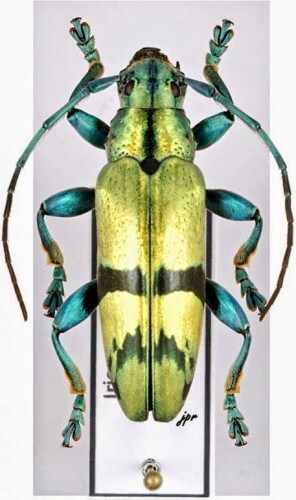The researchers, Zhongze Gu, Zhuoying Xie, Chunwei Yuan, studied a certain type of beetle called Isabellae Tmesisternus, whose colors change from red to gold following changes in humidity in its environment. They found that the change occurs when the beetle's wings absorb moisture. The moisture changes the properties of the scaly layers and their optical properties

Researchers in China have developed a new type of ink that can change color and could be an advantage in the fight against counterfeit currency. The researchers, Zhongze Gu, Zhuoying Xie, Chunwei Yuan, studied a certain type of beetle called Isabellae Tmesisternus, whose colors change from red to gold following changes in humidity in its environment. They found that the change occurs when the beetle's wings absorb moisture. This situation causes changes in the thickness of the layers of scales in the beetle's wings, and as a result changes the way in which the light is reflected from them and therefore also the change in the color of the wings.
Inspired by this phenomenon, the researchers developed a new ink, based on a CPC (colloidal photonic crystals) material. It is actually a suspension of nanometer photonic crystals, which can be used to obtain a wide range of optical properties. Different types of CPC appear to have the same color under certain environmental conditions, but when exposed to vapors of specific materials, each type reflects light slightly differently.
The possibility of using photonic crystal particles has been investigated worldwide for a variety of applications, but so far the subject has not become commercial due to the difficulty in application and the high cost of dispersing the particles on different surfaces. Innovative use of inkjet printers allowed for the first time control over the size and quantity of the ink, and thus the team was able to combine different types of particles to create complex patterns that change colors when exposed to vapors, such as ethanol vapors, for example. The complex and reversible color changes obtained with the new ink are very easy to detect with the naked eye, but on the other hand, they are difficult to imitate. In addition, unlike the current technologies that are based on pigments or polymers, the new ink does not fade due to exposure to light or bleach, and is therefore ideal for integration into applications that require protection against counterfeiting, such as banknotes. The ability of the ink to react to external stimuli, and the ability to print it on both hard and flexible surfaces opens up the possibility of integrating this new technology for additional uses, such as arrays of sensors, multi-functional computer chips, or in dynamic display screens.

2 תגובות
for the first collection,
It is a linguistic matter, since the word min has other connotations it is almost never used in the Hebrew language in other keys, and the word type has taken its place even though it is wrong. In addition, in Israel, unlike other places like Europe, there is almost no taxonomic knowledge. Readers don't really care if it's a species, a genus, or if the beetle belongs to the Hecaronidae family.
For some reason the confusion in the lists continues:
Why aren't the writers in "Innovation from Nature the Israeli Biomimicry Organization"
Do you follow the correct concepts in zoological sorting?
Why don't they make the difference between sex and type?
Isabellae Tmesisternus
is the name of a species ... not a "genus",
There is a difference and it is important that those who write understand the differences
and write accordingly.